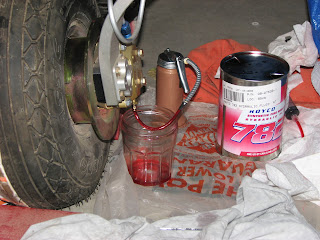The longer bolts had arrived more than a week ago but other things kept me from getting back to work.
I didn't do more during the past week than checking that the length of the AN5-23A bolts were really the right ones. And they were.
Today, I got around to putting all back together. One leg was already on but needed some wiggling and adjusting and torquing to finish the job and the right side needed the whole installation done.


These are the longer AN5 bolts and you can see that they are just the right size. The shorter -22As were not getting through the lock feature of the nuts unless they'd be torqued to final specs and how could you measure the friction torque that way?
I also drilled out some of the CherryMax
® rivets I had found earlier. Here's one picture showing the fixed up right side after replacing one rivet. It's the second from the left and I pulled it from below as you can see.

The next one shows the not so pretty left side. The outer rivets are pulled short but the aft one had a drill bit broken off in it when I tried to remove it. I decided to just add an additional hole and set an additional rivet instead of removing these. The access is really nasty and I did not want to break off another drill bit.

There was still one rivet in those added holes that did not set right and I replaced the rivet today. I did the very same thing as the first time and this time it pulled just fine.
By the way, I found so far that the best way of removing one of the these CherryMax
® rivets is to do just like with ordinary rivets. Drill off the head, either with a bare drill bit or with one of the rivet removers that align the bit by using the circumference of the head. Once the head's removed, use a steel punch and a hammer and drive the stem out. That went very well for me but the rivets were obviously not really set, so keep that in mind.
After the rivet replacements I got to install the right leg and put all the nuts and bolts back in place.

This also provided for a nice angle shot at the AN5 bolts on the right side that shows very nicely how the longer bolts are perfect.

Then everything was torqued to specs but not yet marked with torque seal as I will re-torque everything right before the inspection and then seal it.


The last step was to get the plane off the sawhorses with the help of my wife.

Finally, after 34.5 hours, the legs are back on and the plane is off the sawhorses. I'm not completely done with the SB though. I still need to clean up the interior, remove some debris in hard to reach places and reinstall the ELT before I can tick this SB off.





























